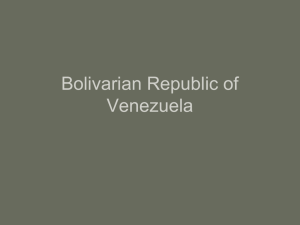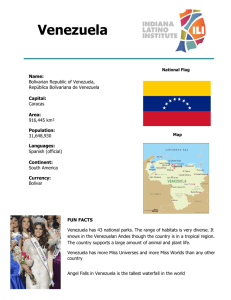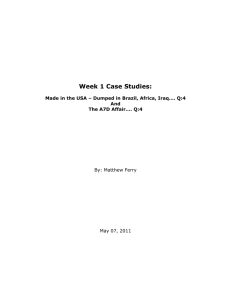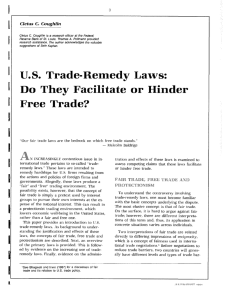The Political, Legal, and Technological Environment of Global
advertisement
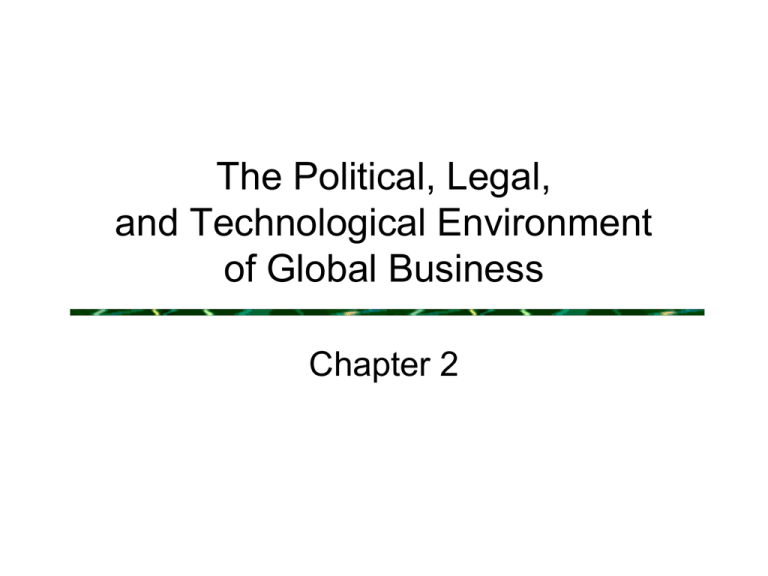
The Political, Legal, and Technological Environment of Global Business Chapter 2 Chapter Outline • • • • • Political systems Four global foundations of law Principles of international law Legal and regulatory issues Technological environment and global shifts in production Political Systems • Democracy: government by citizens or by elected officials – – – – – Fair and free elections Freedom of the press, speech, assembly, and religion Economic freedom Non-political police and court system Civilian control of the military • Democracies are often called “free countries”. Political Systems (2) • Totalitarianism: one political party or individual exerts control over every part of political and human life – Communist totalitarianism – Theocracy: government based on the principles of a particular religion. Most theocracies today are based on Islam – Right-wing totalitarianism allows some economic freedom but not political freedom. Often a military dictatorship • Totalitarian states are also called “dictatorships”. Source: www.freedomhouse.org “Partly free” countries have some characteristics of a democracy and some characteristics of a dictatorship Four Global Foundations of Law • • • • Islamic law Socialist law Common law Civil law Four Global Foundations of Law Islamic Law • Derived from interpretation of the Qur’an and teachings of Prophet Muhammad • Found in some Islamic countries – Middle East – Central Asia Four Global Foundations of Law Socialist Law • Originally, business and other property were owned by the state – Still true in Cuba and North Korea • Mixture of state-owned and private enterprise in Russia, China, Vietnam – Government still takes an active role in business – Many regulations – Arbitrary and inconsistent enforcement of regulations Four Global Foundations of Law Common Law • Comes from English law • Based on custom and precedent (previous cases) • There are also written law codes. • Foundation of legal system in United States, Canada, England, Australia, India, and New Zealand Four Global Foundations of Law Civil Law • Derived from Roman law – Western and central Europe – Some Latin American countries – Louisiana state law • Cases are decided on the basis of written law codes Principles of International Law • Sovereignty: governments have the right to rule as they see fit. • International jurisdiction – A country has jurisdiction within its legal territory – A country has power over its citizens and businesses, wherever they are located – A country has jurisdiction over actions that harm its national security, even if those actions occurred outside its territory Principles of International Law (2) • Doctrine of comity: Governments show mutual respect for the laws, institutions, and governments of other countries who are exercising jurisdiction over their own citizens (doctrine but not law) • Act of State Doctrine (U.S. law): All acts of other governments are considered to be valid in U. S. courts Principles of International Law (3) • U. S. courts do not have to settle civil cases brought by foreign citizens or firms in U. S. courts. • Treatment of aliens – Countries have the legal right to refuse admission of foreign citizens and to impose restrictions on their conduct, right of travel, where they can stay, and what business they may conduct – Countries can also can deport citizens of foreign countries Examples of Legal and Regulatory Issues • Privatization has opened up new business opportunities. • Nationalization • Regulation of trade and investment – WTO rules on trade and investment – Antidumping regulations and countervailing duties – How companies can protect themselves in trade disputes Nationalization • Nationalization is the conversion of a private enterprise to government ownership. Almost always initiated by the government. – The government may or may not pay the company's stockholders or investors for the enterprise. – When the companies are paid for the property, the price is usually set by the government and is usually far below the market value of the property. – When no payment is made, the conversion is called expropriation or confiscation Nationalization in Russia • Russia has large oil reserves and the world's largest reserve of natural gas. • Russia privatized its energy industry in the 1990's and re-nationalized most of it in 2006. • In late 2006, Russia forced Shell and several other western companies to sell a controlling interest in a major oil drilling venture to the government energy company (Gazprom), which is now a monopoly. • BP had a joint oil venture with several Russian investors. Russia forced BP to give majority control to the Russian investors. Nationalization in South America • Most government enterprises in South America were privatized in the 1980's. • In the 1990’s, nearly all South American countries had democratically elected governments and market economies. – In several South American countries, poor and indigenous people did not believe that they had benefited from this system. • Socialist presidents have been elected in Bolivia, Ecuador, Venezuela, Nicaragua, and Argentina. Nationalization in South America (2) • Venezuela ordered 6 foreign oil companies to sell a controlling interest in their businesses to Venezuela’s national oil company or shut down their businesses in Venezuela. Four companies complied, and two left. • Venezuela has also nationalized a number of local companies. • Bolivia has nationalized hundreds of companies and may also nationalize its oil industry. • Ecuador has also nationalized some companies. WTO Rules on Trade and Investment • These are examples of trade practices that are forbidden under WTO rules: – Government financial support for local firms (subsidies) – Requiring MNCs to accept local partners – Import tariffs that are higher than WTO agreements allow – “dumping” goods in foreign markets Dumping • Dumping occurs when – a company sells a product in a foreign market for less than the cost of production and shipment or – a company sells a product in a foreign market for less than the price charged in the home country • It is often hard to prove that a company has sold a product below cost. Countervailing Duties • The World Trade Organization allows its members to punish dumping by charging an import tariff, called a countervailing duty. • In most countries, these tariffs can be imposed if – the government investigates and concludes that dumping has occurred AND – domestic producers can show that they have been harmed by dumping • Countervailing duties can also be imposed if a domestic producer has been harmed by subsidies. How Companies Can Protect Themselves in Trade Disputes • Companies should monitor trade disputes – Retaliatory tariffs and quotas are often imposed on products that are not involved in the original dispute – EU retaliated against U.S. steel tariffs by raising tariffs on U. S. citrus fruit and textiles – Companies can lobby their own government to settle the dispute or to persuade the foreign government to remove their products from the list Technological Environment and Global Shifts in Production • E-business capabilities • E-business issues – Language translation software for India • Biotechnology – Genetically modified crops – Biofuels, such as ethanol • Outsourcing and offshoring – Manufacturing – Knowledge work – Expert systems E-Business Capabilities • Business-to-business e-commerce: global purchasing, sales, collecting payment, financial services • Business-to-consumer: – – – – Online purchasing and payments Online financial services Debit cards and electronic cash Wireless communication, cell phones, and phone cards improve communication in remote areas and poor countries E-Business Issues • Electronic technology and standardization – GSM vs. CDMA technology for telecommunications – Microsoft Windows vs. Linux • Linux is open source software that can be modified by users. Ubuntu is a version of Linux that is more suitable for end users than earlier versions. • Reliability of telecommunications • Software for language translation • Web sites in various languages Example: Language Translation Software for India • Hindi is the national language of India. About 420 million people speak Hindi as their first language. • Most other people from India speak one of 22 regional languages as their first language. • These languages have different scripts. • Quillpad software allows users to use a standard keyboard to type words phonetically and have them translated into Hindi and 9 regional languages. English words can also be translated into those languages


